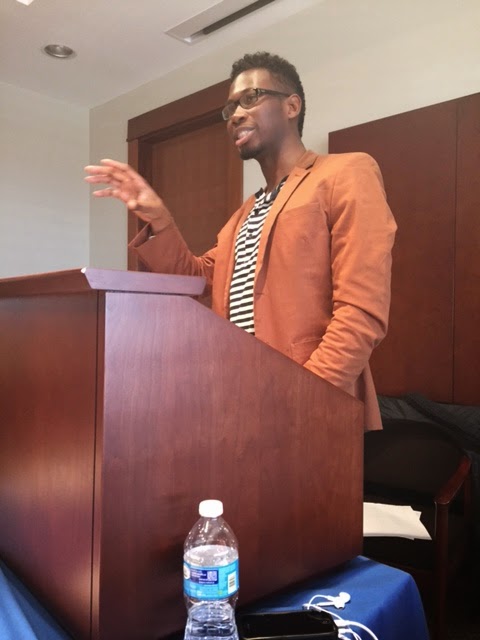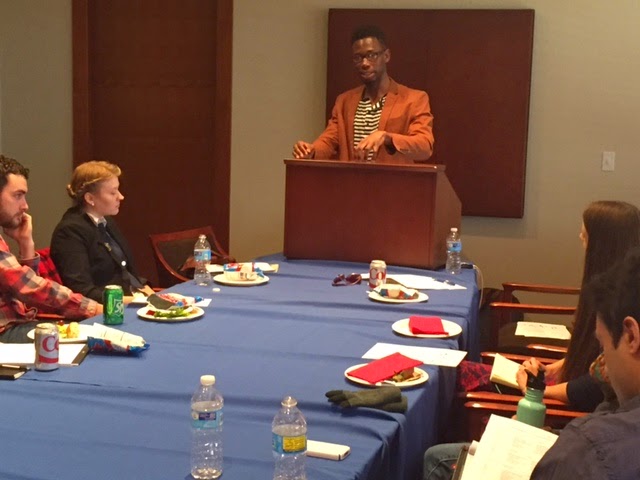This content is being reviewed in light of recent changes to federal guidance.
“Characteristics of Negro Expression”: Kenton Rambsy on the Importance of Digital Humanities in the Study of African American Short Stories
 On February 11, 2015, Hall Center Research Fellow and KU English Ph.D. candidate Kenton Rambsy presented on notable outcomes of his dissertation research in his interdisciplinary graduate research workshop, “Characteristics of Negro Expression: Digital Humanities and African American Short Stories,” at the University of Kansas.
On February 11, 2015, Hall Center Research Fellow and KU English Ph.D. candidate Kenton Rambsy presented on notable outcomes of his dissertation research in his interdisciplinary graduate research workshop, “Characteristics of Negro Expression: Digital Humanities and African American Short Stories,” at the University of Kansas.
Rambsy’s work employs a digital humanities approach through text-mining software to understand African American short stories. Rambsy began his research by examining the more recent work of Edward P. Jones, finding that the word “street” comes up 42 times in his story “Bad Neighbors.” This observation led him to examine other canonical African American short story writers, particularly those he deems “The Big Seven”: Zora Neale Hurston, Richard Wright, James Baldwin, Charles Chesnutt, Ralph Ellison, Toni Cade Bambara, and Alice Walker. The Big Seven are authors whose stories appear most frequently across a sample of 100 anthologies. Rambsy’s research considers the prevalence of geography and place in a practice that he calls “geo-tagging,” or when authors use particular language in order to mark specific or regional locations in their work.
In text-mining the stories of Edward P. Jones, Rambsy was able to identify not only the frequency of the word “street” but also the manners in which it is used. The data allowed him to track and compare when “street” is written as a subject in a dependent clause to indicate that a character is moving to or through that street versus when it is used as the main subject of a sentence. He concludes that in this way, the language of Jones’s stories charts the specifics of the city’s environment. Looking at the pieces together, Jones’s stories indicate the multiplicity of black experience in Washington, D.C.
 In the work of The Big Seven, Rambsy identifies three common geographic settings: New York City, the Black South, and the Black/White South. Stories set in New York City often pinpoint specific geographic locations, such as Lenox Avenue and Greenwich Village in Baldwin’s “Sonny’s Blues.” However, in the South as anthologized in black literature, specific naming of places is often avoided; states are mentioned, but cities and towns are not usually named, which enables readers encountering the story to understand it as a general black southern experience. The distinction Rambsy draws between the Black South and the Black/White South rests on the nature of the central conflict driving the story. For example, in the work of Zora Neale Hurston and Alice Walker, the stories are not driven by black/white interaction, as opposed to Ellison, Wright, and Baldwin’s stories.
In the work of The Big Seven, Rambsy identifies three common geographic settings: New York City, the Black South, and the Black/White South. Stories set in New York City often pinpoint specific geographic locations, such as Lenox Avenue and Greenwich Village in Baldwin’s “Sonny’s Blues.” However, in the South as anthologized in black literature, specific naming of places is often avoided; states are mentioned, but cities and towns are not usually named, which enables readers encountering the story to understand it as a general black southern experience. The distinction Rambsy draws between the Black South and the Black/White South rests on the nature of the central conflict driving the story. For example, in the work of Zora Neale Hurston and Alice Walker, the stories are not driven by black/white interaction, as opposed to Ellison, Wright, and Baldwin’s stories.
Rambsy’s work underscores the value of a data-driven approach to understanding literature and its shaping. Text-mining allows us to study linguistic features specific to black literature, such as black vernacular and the significance of place language. Rambsy argues that digital humanities is not a replacement for traditional scholarship. Rather, it invites new and different questions about the texts we study.
Stefanie Torres grew up in Austin, Texas, before moving to Lawrence for graduate school at the University of Kansas. She has worked on the graduate student-run journal Beecher’s since its inception and served as co-editor-in-chief for two years. Her work has appeared in The Whistling Fire. She holds an MFA from KU and is currently a Ph.D. candidate in nonfiction creative writing at the same institution.
Jennifer Colatosti is a Ph.D. candidate at the University of Kansas specializing in American Literature and Fiction Writing. Her work has been published or is forthcoming in Sequestrum, Southeast Review, and The MacGuffin, among other journals.